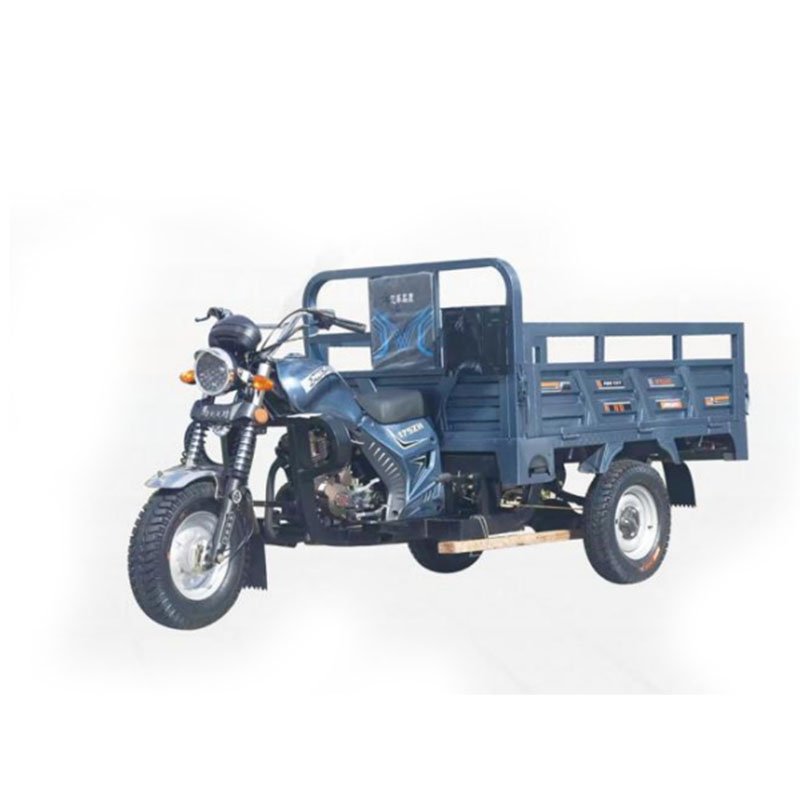
At four in the morning, at the entrance of the vegetable market, the headlights of fuel-powered three-wheeled cargo motorcycles cut through the thin mist. Lao Li, a vegetable farmer, skillfully stacks just-picked green beans into the cargo box. When the tailgate closes, it shakes gently twice—this “old partner” that has been with him for five years has carried frost-bitten cabbages, dew-covered cucumbers, and his dream of sending his daughter to college in its cargo bed. As the first rays of dawn climb the edge of the cargo box, the fuel-powered three-wheeled cargo motorcycle has already arrived at the stall with fresh produce, turning every ounce into the steadiness of life.
On the winding mountain roads of the Sichuan-Chongqing region, fuel-powered three-wheeled cargo motorcycles are more punctual than alarm clocks. Aunt Wang travels twenty li of mountain roads every day to sell homemade chili sauce. Although the vehicle body gently颠簸 (jostles) at steep bends, not a drop of sauce has ever spilled. The glass jars in the cargo bed sway to the rhythm of the engine, reflecting the green of the distant tea gardens and her wish to save money to renovate her ancestral home. This steady climbing companion shortens the mountain paths, delivering the warmth of every handmade product on time to the door of the town’s general store.
In the back alleys of the city, fuel-powered three-wheeled cargo motorcycles are the invisible wings of small and micro enterprises. Master Zhang, who runs a hardware store, visits three construction sites daily. In the narrow old neighborhoods where large trucks cannot enter, this “little guy” takes center stage. He always delivers welding machines and water pipe fittings before the morning rush hour. When he sees workers nod as they receive the materials, he knows that the dusty cargo bed carries not just goods, but the trust and expectations of entire projects.
Under the neon lights of night market stalls, fuel-powered three-wheeled cargo motorcycles transform into entrepreneurship incubators. Sister Chen, who sells grilled cold noodles, props up her iron plate stand on the cargo bed—when the taillights come on, it’s a signal to open for business. The aroma of fried eggs mixes with the residual warmth of the engine, and the sauce bottles in the cargo bed sway gently in the evening breeze. This vehicle, which transported vegetables during the day, now becomes the starting point of her dreams. Every late night after closing the stall, it silently carries tables, chairs, and ingredients back to the rental house in the urban village, transporting the day’s harvest and the hope of tomorrow.
At the entrance of suburban logistics parks, fuel-powered three-wheeled cargo motorcycles form a green flowing landscape. Kang, a delivery driver, always has stickers drawn by his daughter on his vehicle. He says that every time he makes a delivery, the parcels in the cargo box carry different stories—warm clothes sent by young people to their parents, milk powder stocked by new mothers, and samples shipped by entrepreneurs across the country. This companion that shuttles between buildings ensures that every expectation is not blocked by distance, giving tangible meaning to every busy day.
Fuel-powered three-wheeled cargo motorcycles have never been the protagonists in the spotlight, yet in every morning that requires setting out and every night that returns with a full load, they become the backbone of millions of lives through silent companionship. They are the starlight under the wheels of vegetable farmers, the smooth path on the shoulders of mountain dwellers, the mobile shops of small merchants, and the first “storefront” for entrepreneurs. Choosing one is not just choosing a machine, but a partner to share storms and sunshine—making every departure full of hope and ensuring that every effort is steadily carried.
